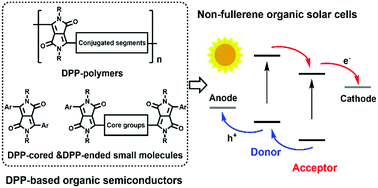Diketopyrrolopyrrole-based conjugated materials for non-fullerene organic solar cells
Abstract
Non-fullerene organic solar cells (NFOSCs) have attracted much attention in recent years since non-fullerene conjugated materials show many advantages, such as structural versatility, tunable absorption, energy levels and crystallinity compared to fullerene derivatives with limited material selection. Therefore, NFOSCs have achieved high power conversion efficiencies over 15%. Innovation of conjugated materials is the key factor to improve the photovoltaic performance. The diketopyrrolopyrrole (DPP) unit has been widely incorporated into conjugated materials with near-infrared (NIR) absorption spectra due to its strong electron-withdrawing ability. DPP-based conjugated materials also show strong crystallinity and high hole/electron mobilities, indicating that they can be used as both electron donors and electron acceptors in organic solar cells. In this review, we have focused on DPP-based conjugated materials for application in NFOSCs, including (i) DPP-based polymer donors, (ii) DPP-based small molecule donors, (iii) DPP-based polymer acceptors and (iv) DPP-based small molecule acceptors. We will highlight the structural design in these materials, and the selection of donors/acceptors to match with DPP-based conjugated materials. In the last part, we will provide perspectives about the design of DPP-based materials for application in NFOSCs in the future.

- This article is part of the themed collections: Recent Review Articles and 2019 Journal of Materials Chemistry A HOT Papers


 Please wait while we load your content...
Please wait while we load your content...